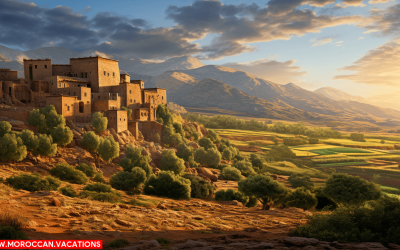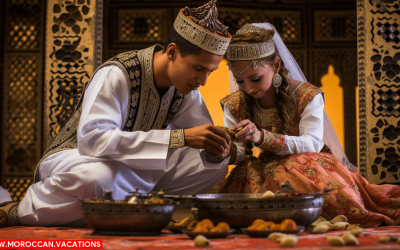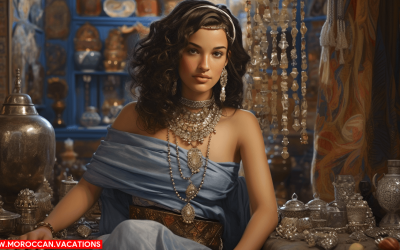Historical Background of Riads
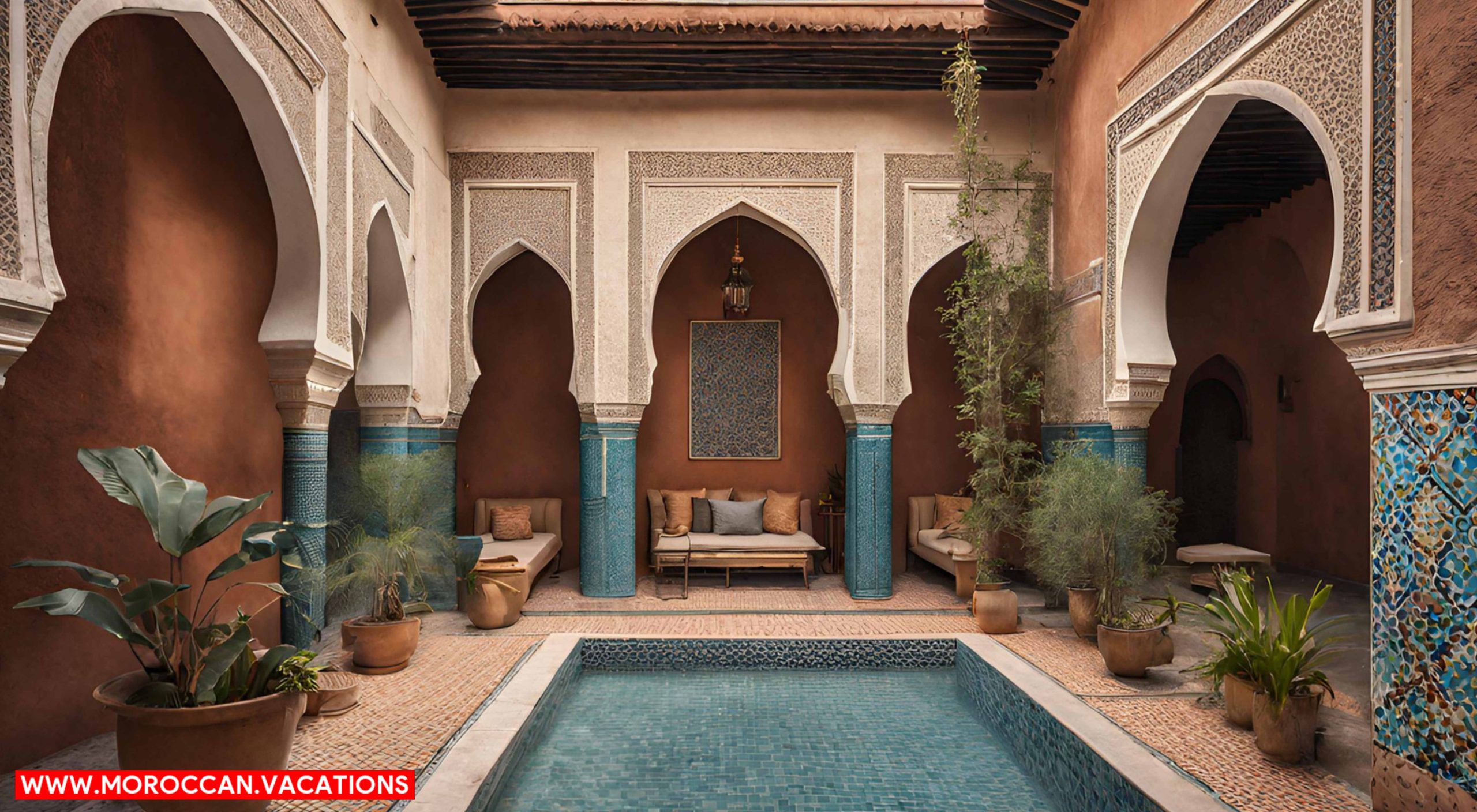

Imagine wandering through the labyrinthine streets of Marrakesh, the air thick with the aroma of spices and the sounds of bustling marketplaces. As you turn a corner, you stumble upon a hidden oasis – a riad. These traditional Moroccan houses, with their vibrant courtyards and intricate architecture, not only serve as a sanctuary from the city’s chaos but also play a vital role in shaping Marrakesh’s architectural identity. Let’s delve into the captivating world of riads and explore their significance in this captivating city.
To understand the historical background of riads in Marrakesh, you need to delve into their origins and development throughout the centuries. The history of riads can be traced back to the medieval period when Islamic architecture flourished in Morocco. Riads were initially built as luxurious private residences for the wealthy elite, reflecting the opulence of the ruling class.
The origins of riads can be attributed to the influence of Andalusian architecture, brought to Morocco by Muslim refugees fleeing Spain during the Reconquista. This fusion of Andalusian and Moroccan architectural styles gave birth to the unique design of riads, characterized by their inward-facing structure, central courtyard, and intricate geometric patterns.
Over time, riads evolved to adapt to the changing needs of their inhabitants. As Marrakesh grew and urbanization took hold, riads began to serve multiple purposes. They became communal spaces where families would gather, businesses would be conducted, and cultural events would take place. This transformation allowed riads to become integral to the social fabric of Marrakesh, playing a significant role in shaping the city’s identity.
Today, riads are not only cherished for their historical significance but also for their architectural beauty. Many riads have been restored and transformed into boutique hotels or guesthouses, allowing visitors to experience the rich history and cultural heritage of Marrakesh firsthand. The origins of riads may lie in the past, but their relevance and allure remain timeless.
Architectural Elements of Riads
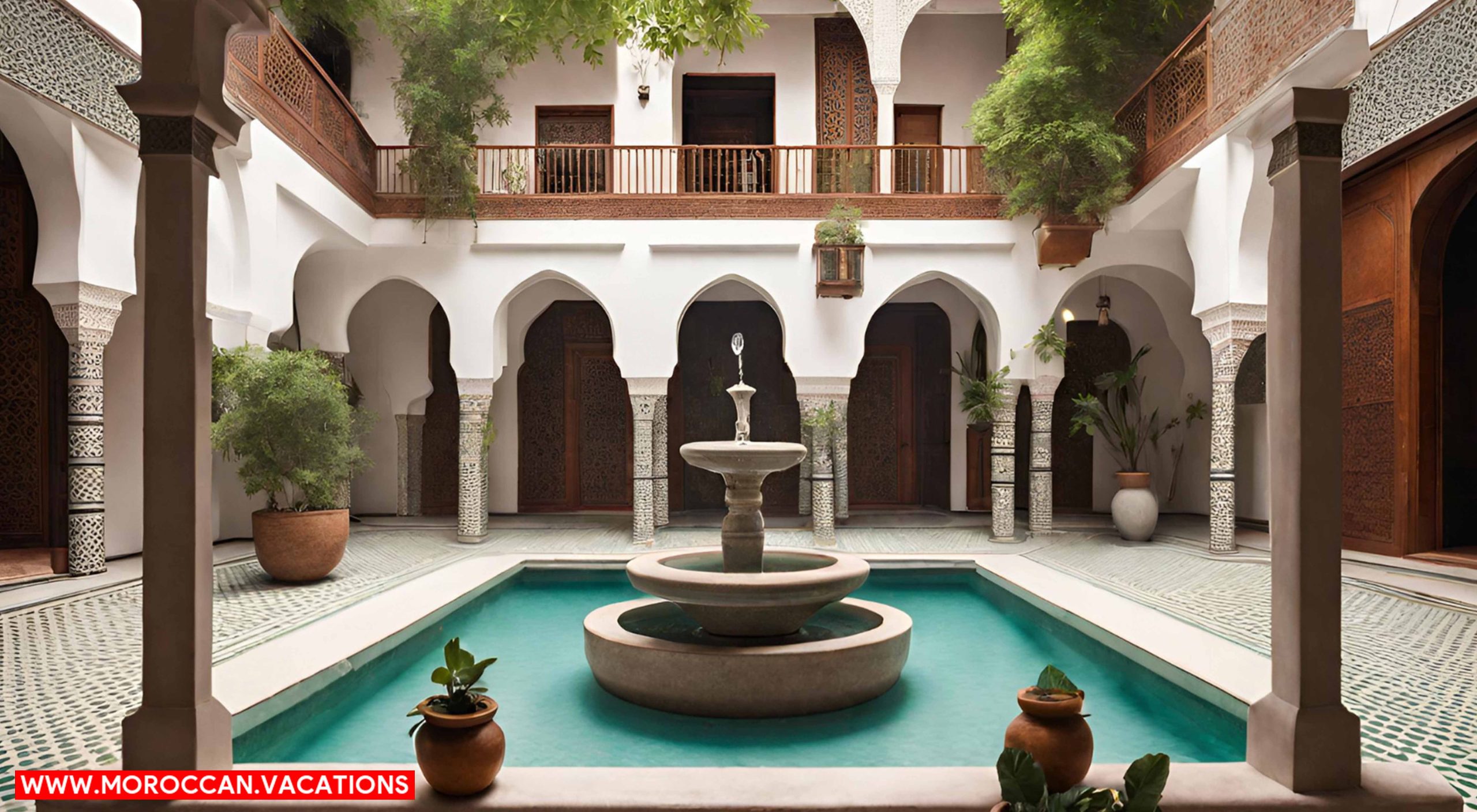

As you delve into the architectural elements of riads, you will discover their distinctive features that contribute to Marrakesh’s unique identity. Riads are known for their courtyard design, which is a central feature that provides a peaceful and private oasis in the midst of the bustling city. The courtyard typically has a fountain or pool at its center, surrounded by lush greenery and colorful tiles. This design not only adds beauty to the riad but also helps to keep the interior cool during the hot summers.
Traditional materials play a significant role in the construction of riads. The walls are often made of rammed earth or adobe, which helps to regulate the temperature inside. The use of local materials not only reflects the cultural heritage of Marrakesh but also ensures sustainability and a connection to the surrounding environment.
In addition to the courtyard and traditional materials, other architectural elements that define riads include:
- Ornate doors: Riads are often adorned with intricately carved wooden doors, showcasing the craftsmanship and attention to detail of Moroccan artisans.
- Decorative tilework: Zellige, a form of mosaic tilework, is commonly found in riads. The geometric patterns and vibrant colors add a touch of elegance and beauty to the interior.
- Riad rooftops: The rooftops of riads are often flat and offer stunning views of the cityscape. They provide a space for relaxation and socializing, as well as a place to enjoy the warm Moroccan sun.
- Riad gardens: Many riads feature beautifully landscaped gardens, filled with fragrant flowers, citrus trees, and herbs. These gardens not only provide a pleasant aesthetic but also contribute to a sense of tranquility within the riad.
These architectural elements come together to create a unique and enchanting atmosphere that is characteristic of Marrakesh. By preserving and celebrating these elements, riads continue to play a vital role in the city’s architectural identity.
Transformation of Riads Into Guesthouses
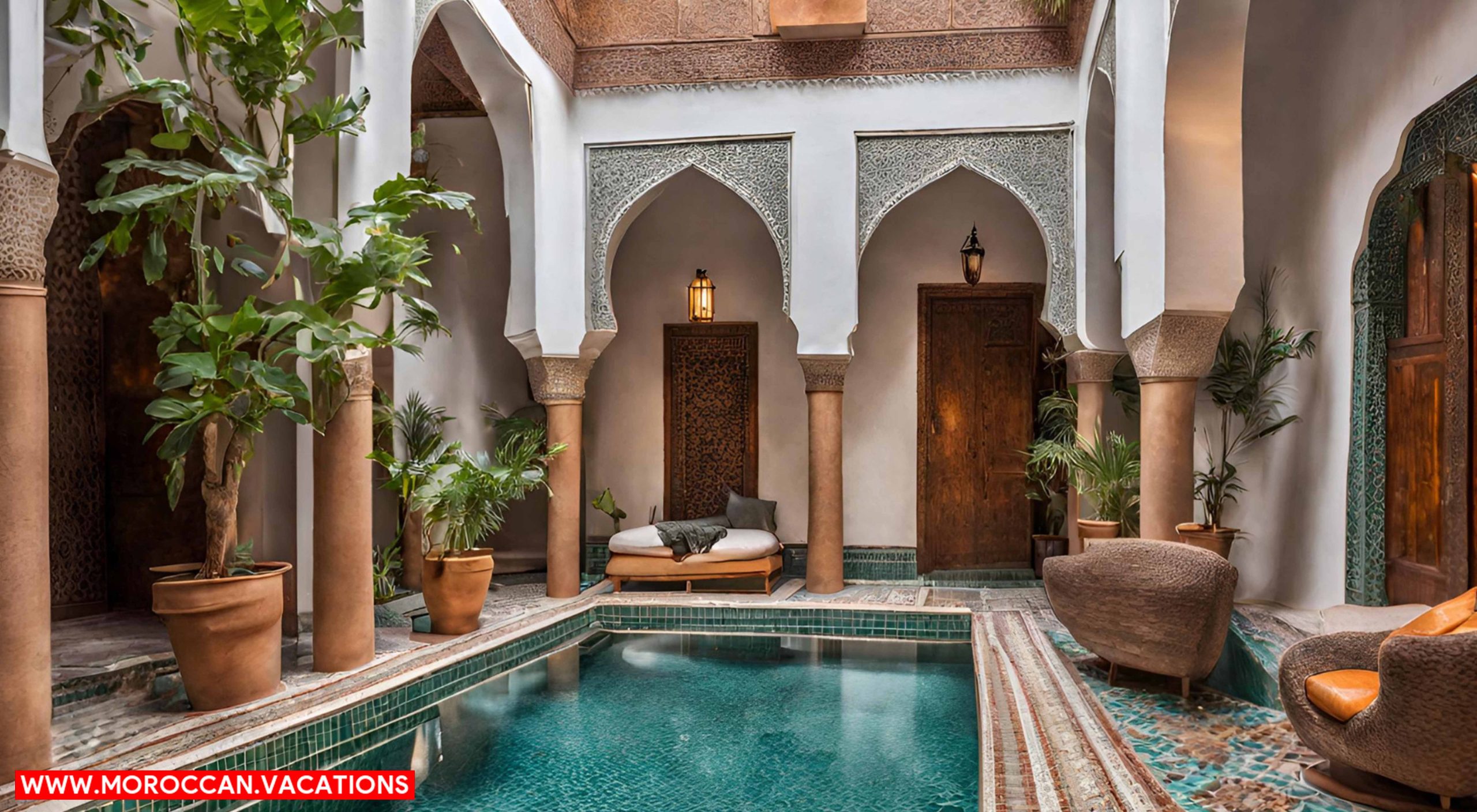

You can explore the transformation of riads into guesthouses, which adds a new dimension to Marrakesh’s architectural identity, by seamlessly blending traditional Moroccan design with modern hospitality. This transformation has presented both challenges and opportunities for riad owners, as they strive to maintain the integrity and historical value of these buildings while catering to the needs of tourists.
One of the main challenges faced during the transformation process is the preservation of the riad’s original architectural features. Riads typically feature intricate tilework, carved woodwork, and central courtyards, which are essential components of their charm. However, converting these spaces into guest accommodations requires careful planning to ensure that these elements are preserved and showcased in a way that aligns with the modern hospitality standards.
Another challenge lies in adapting the riads to meet the demands of tourism. While traditional riads were designed as private residences, they now need to provide modern amenities and services to cater to tourists’ expectations. This includes adding en-suite bathrooms, air conditioning, and Wi-Fi connectivity, without compromising the riad’s architectural integrity.
The transformation of riads into guesthouses has had a significant impact on Marrakesh’s tourism industry. These unique accommodations offer visitors an authentic experience of Moroccan culture, allowing them to immerse themselves in the city’s rich history and architectural heritage. Moreover, the rise of riad guesthouses has contributed to the diversification of accommodations in Marrakesh, attracting a wider range of tourists and boosting the local economy.
Economic Impact of Riads on Marrakesh
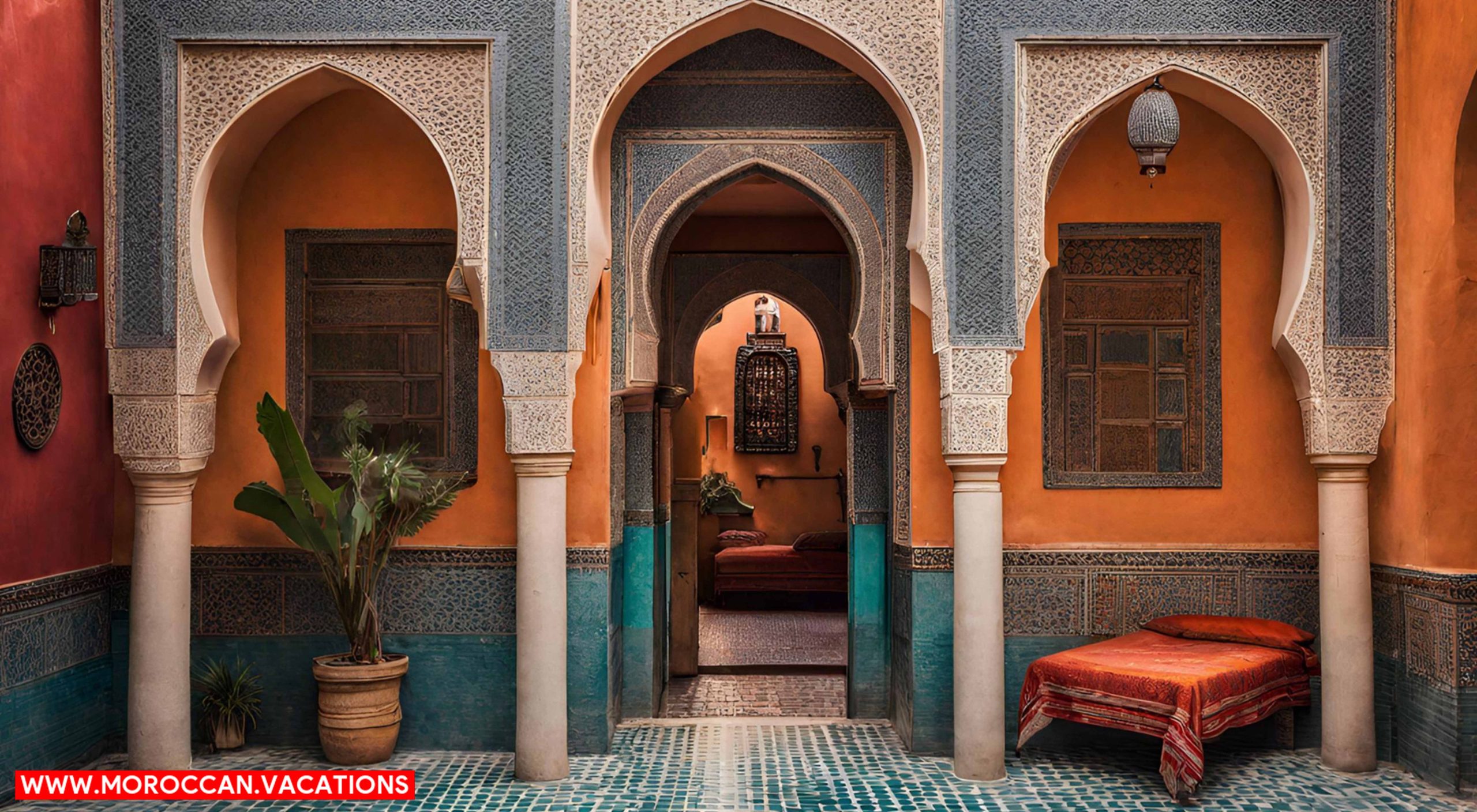

The economic impact of riads on Marrakesh can be seen in the increased revenue generated by the tourism industry. Riads, with their unique architecture and traditional Moroccan charm, have become major attractions for tourists visiting Marrakesh. As a result, they have contributed significantly to the city’s economy through job creation and tourism revenue.
Here is a list highlighting the economic impact of riads on Marrakesh:
- Job creation: The transformation of riads into guesthouses has created numerous job opportunities for locals. From construction workers to hospitality staff, riads have provided employment to a wide range of individuals, boosting the city’s economy and reducing unemployment rates.
- Tourism revenue: The popularity of riads has attracted a growing number of tourists to Marrakesh. Tourists who choose to stay in riads contribute to the city’s tourism revenue by spending money on accommodations, dining, and local experiences. This influx of tourism income has a positive ripple effect on the local economy.
- Ancillary businesses: The presence of riads has also led to the growth of ancillary businesses in Marrakesh. Local artisans, craftsmen, and suppliers benefit from the demand for traditional Moroccan furnishings, decorations, and amenities for riads. This further stimulates the economy and promotes the preservation of traditional Moroccan craftsmanship.
- Economic diversification: Riads have played a significant role in diversifying Marrakesh’s economy. While the city has long been known for its vibrant souks and historical sites, the rise of riads as popular accommodations has added a new dimension to the tourism sector, attracting a broader range of visitors and increasing overall tourism revenue.
Cultural Significance of Riads in the City
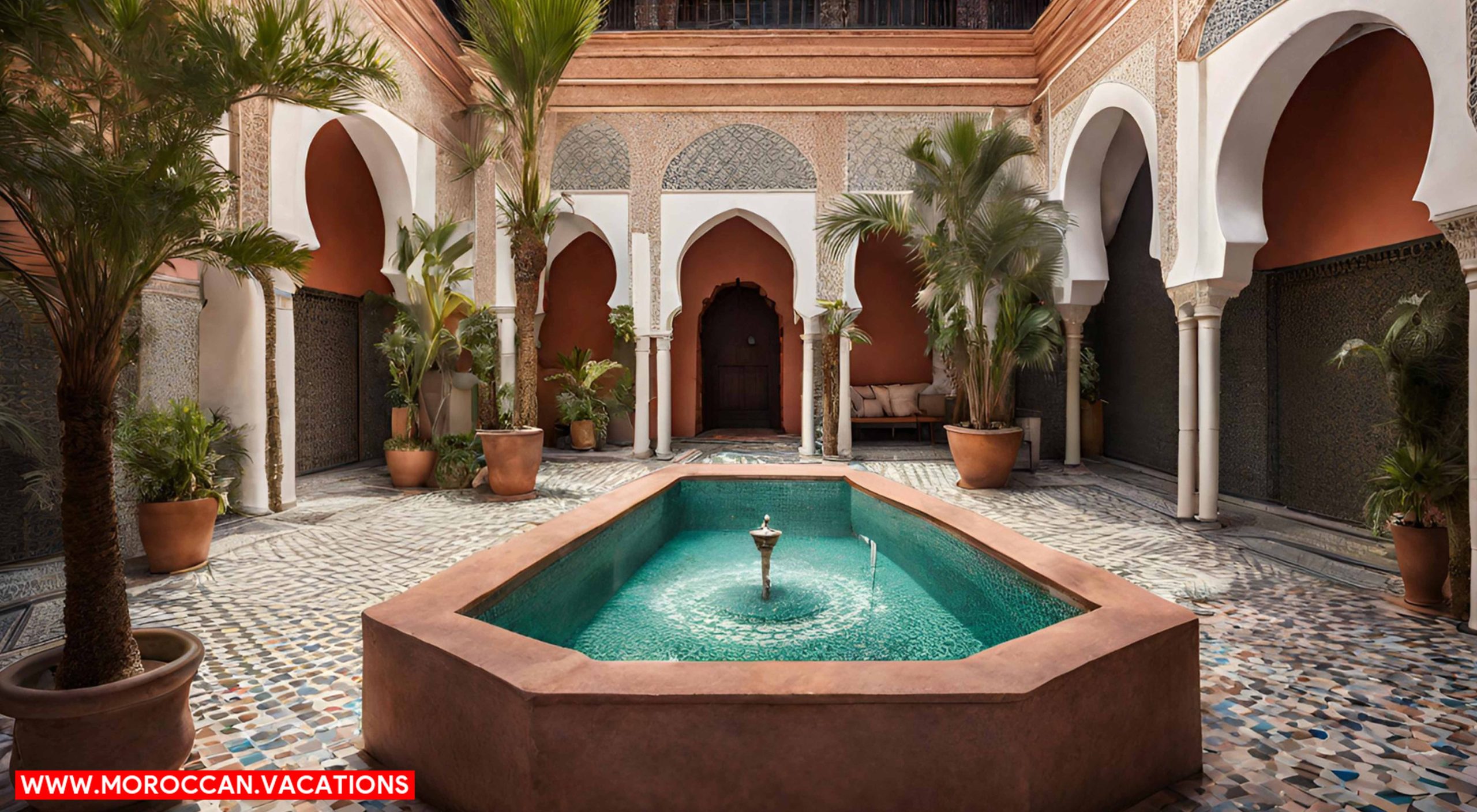

The cultural significance of riads in Marrakesh’s architectural identity is evident in their preservation of traditional Moroccan design and craftsmanship. These stunning courtyard houses have become a symbol of cultural preservation in the city, attracting tourists from around the world. Riads serve as a living testament to the rich history and heritage of Marrakesh, showcasing the intricate details and skilled craftsmanship that define Moroccan architecture.
One of the key elements that make riads culturally significant is their emphasis on privacy and tranquility. The traditional design of riads centers around an inner courtyard, known as a “dakhla,” which provides a peaceful oasis away from the bustling streets of the city. This architectural feature allows residents and guests to escape the noise and chaos of the outside world, creating a sense of freedom and serenity.
Moreover, riads serve as a showcase for traditional Moroccan craftsmanship. From the elaborate tilework known as “zellige” to the intricately carved wooden ceilings and doorways, every detail of a riad is a testament to the skill and artistry of Moroccan artisans. The preservation and restoration of riads not only contribute to the city’s architectural identity but also support local craftsmen and sustain traditional techniques.
In addition to their cultural significance, riads have also become a major tourism attraction in Marrakesh. Many riads have been converted into boutique hotels, offering visitors a unique and authentic Moroccan experience. Staying in a riad allows tourists to immerse themselves in the city’s rich cultural heritage, providing a sense of freedom to explore and appreciate the local traditions and customs.
Future of Riads in Marrakesh’s Architecture
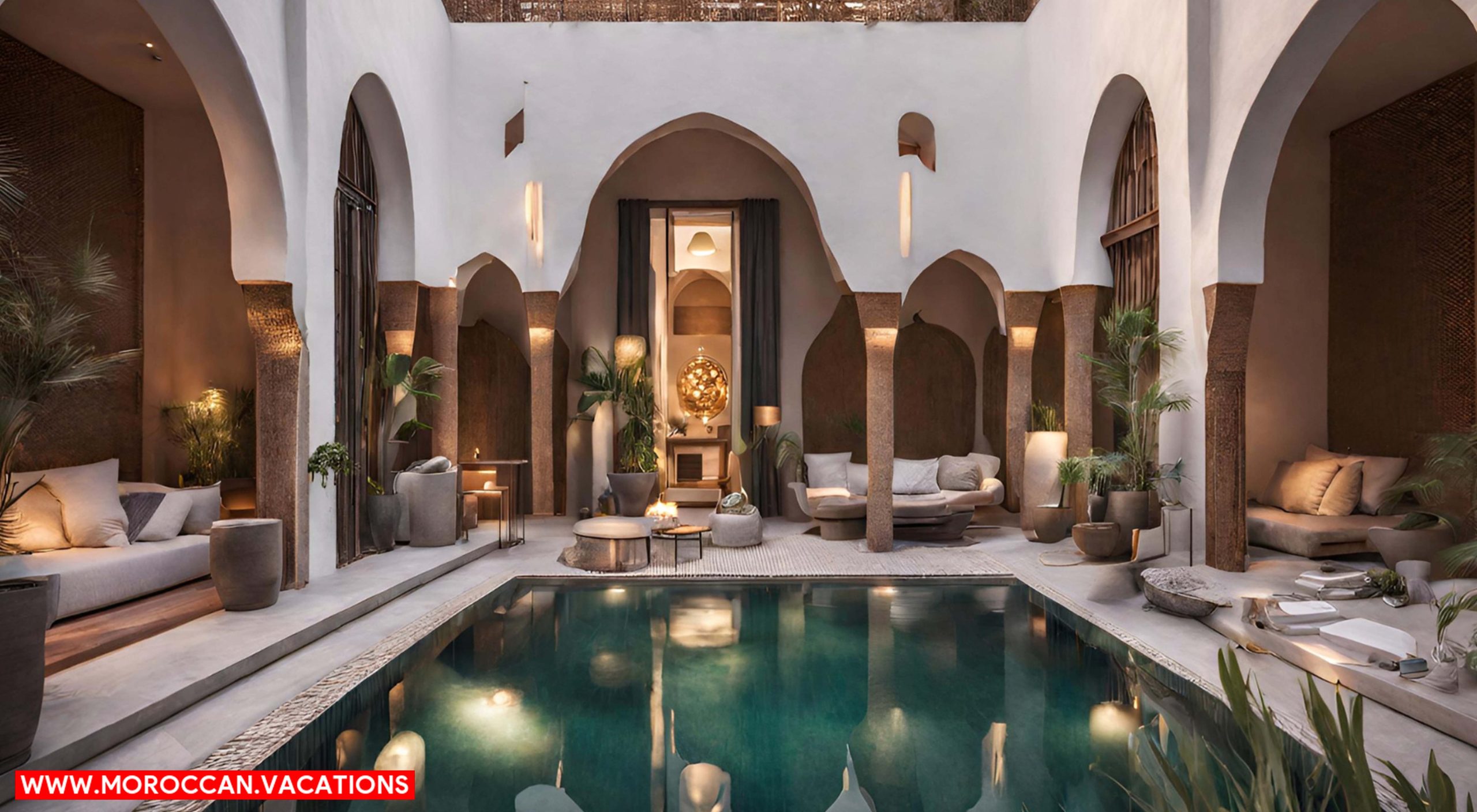

As the city of Marrakesh continues to evolve, the future of riads in its architecture remains uncertain. The traditional riads, with their central courtyards and intricate design elements, have long been an integral part of Marrakesh’s architectural identity. However, as the city expands and modernizes, there are several factors that could impact the future of riads.
- Reimagining Riads: One possibility for the future of riads is a reimagining of their design and purpose. As Marrakesh embraces modernity, architects and designers may find innovative ways to integrate the traditional riad elements into contemporary structures. This could involve incorporating courtyards, decorative tilework, and other traditional features into new buildings, creating a fusion of old and new.
- Sustainable Development: With the growing concern for environmental sustainability, there is a push for more eco-friendly architecture in Marrakesh. Riads, with their natural ventilation systems and use of local materials, are inherently sustainable. Therefore, the future of riads in Marrakesh’s architecture could involve a focus on preserving and promoting these traditional buildings as green alternatives to modern construction.
- Preservation Efforts: Despite the potential challenges, there is a strong desire to preserve Marrakesh’s architectural heritage. Riads are not just buildings; they are repositories of history, culture, and craftsmanship. Efforts are being made to restore and maintain riads, ensuring that they continue to be an integral part of the city’s identity.
- Tourism and Economic Impact: Riads have become popular tourist accommodations, attracting visitors who seek an authentic experience. This tourism boom has provided economic opportunities for Marrakesh. As long as there is a demand for riads, their future in the city’s architecture is likely to remain strong.
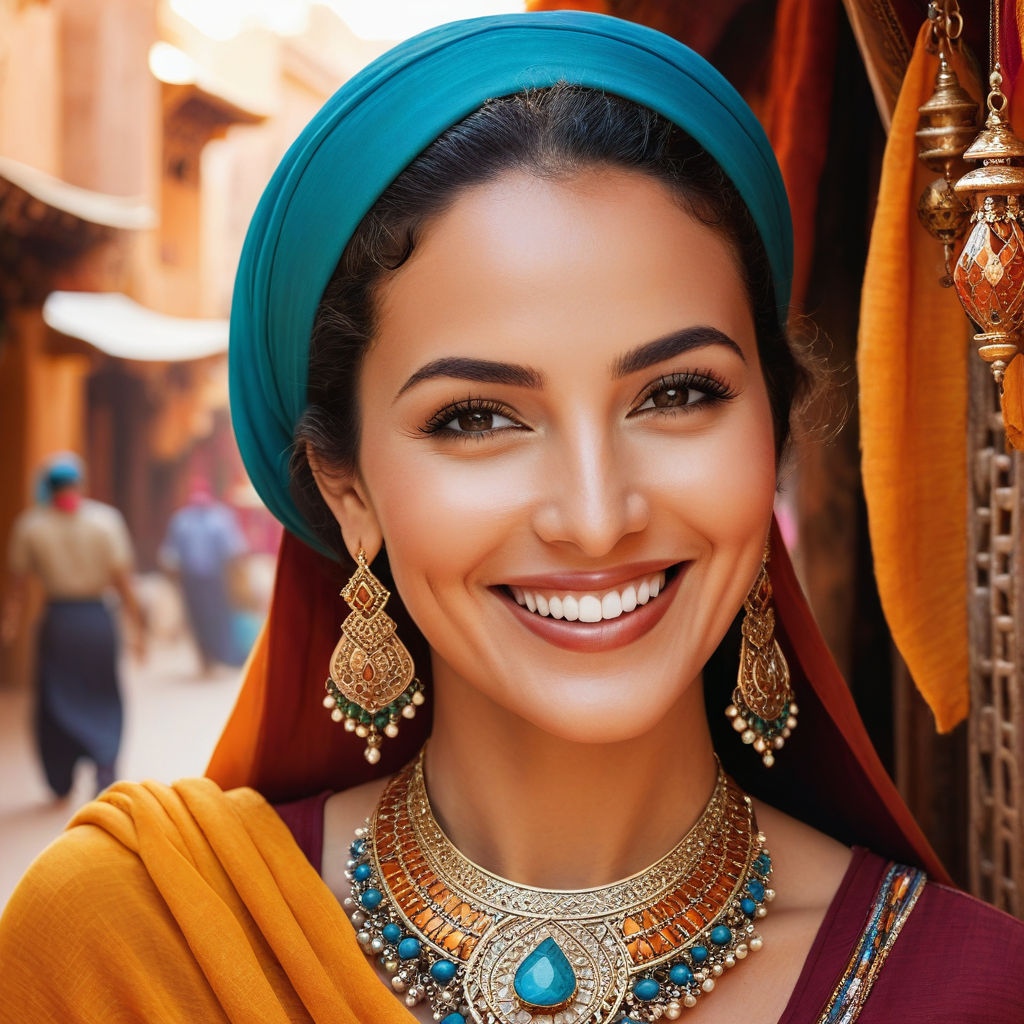

Samira Amrani
The passionate author behind Moroccan Vacations, sharing her expertise and love for Moroccan culture, cuisine, and travel experiences to inspire wanderlust in every reader.
Related Articles
Hidden Gems: Off-the-Beaten-Path Berber Villages
Discover the authentic charm of Berber villages with our off-the-beaten-path tours. Immerse yourself in hidden gems, away from the tourist crowds, and experience the rich culture and breathtaking landscapes of Berber communities.
Unveiling the Rich Traditions: a Glimpse Into Traditional Moroccan Wedding Customs
“Discover the enchanting world of traditional Moroccan wedding customs as we unveil the rich tapestry of time-honored traditions. Immerse yourself in the beauty and significance of Moroccan nuptials with a captivating glimpse into the cultural richness that defines these celebrations. Explore the intricate rituals, vibrant ceremonies, and the deep-rooted customs that make Moroccan weddings truly unique.
A Fashionista’s Guide to Incorporating Traditional Moroccan Jewelry in Modern Style
Discover the perfect blend of tradition and modernity with our Fashionista’s Guide to Incorporating Traditional Moroccan Jewelry in Modern Style. Explore timeless pieces that effortlessly elevate your contemporary wardrobe. Uncover the secrets of merging cultural richness with fashion-forward flair. Elevate your style with the allure of Moroccan jewelry – where heritage meets haute couture.

